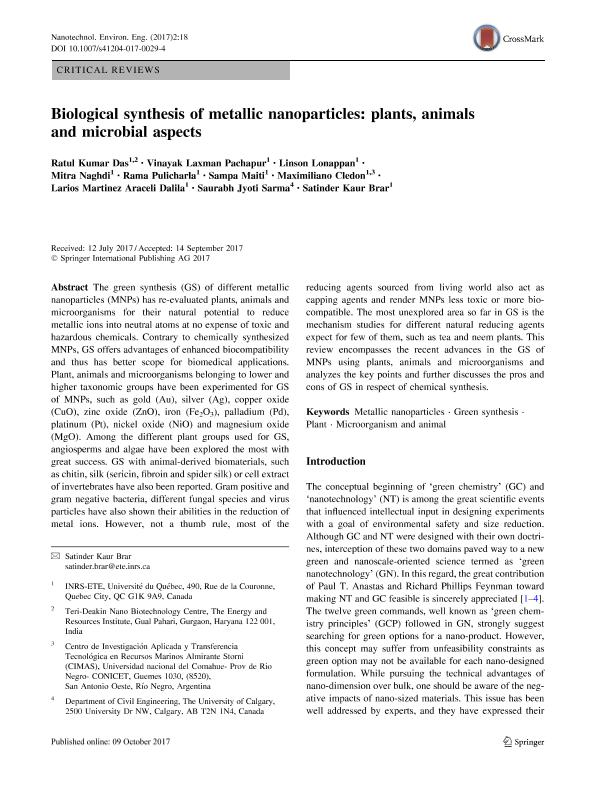Mostrar el registro sencillo del ítem
dc.contributor.author
Das, Ratul Kumar
dc.contributor.author
Pachapur, Vinayak Laxman
dc.contributor.author
Lonappan, Linson
dc.contributor.author
Naghdi, Mitra
dc.contributor.author
Pulicharla, Rama

dc.contributor.author
Maiti, Sampa
dc.contributor.author
Cledón, Maximiliano

dc.contributor.author
Dalila, Larios Martinez Araceli
dc.contributor.author
Sarma, Saurabh Jyoti
dc.contributor.author
Brar, Satinder Kaur

dc.date.available
2019-10-01T20:05:07Z
dc.date.issued
2017-12
dc.identifier.citation
Das, Ratul Kumar; Pachapur, Vinayak Laxman; Lonappan, Linson; Naghdi, Mitra; Pulicharla, Rama; et al.; Biological synthesis of metallic nanoparticles: plants, animals and microbial aspects; Springer; Nanotechnology for Environmental Engineering; 2; 1; 12-2017; 1-21
dc.identifier.issn
2365-6379
dc.identifier.uri
http://hdl.handle.net/11336/84975
dc.description.abstract
The green synthesis (GS) of different metallic nanoparticles (MNPs) has re-evaluated plants, animals and microorganisms for their natural potential to reduce metallic ions into neutral atoms at no expense of toxic and hazardous chemicals. Contrary to chemically synthesized MNPs, GS offers advantages of enhanced biocompatibility and thus has better scope for biomedical applications. Plant, animals and microorganisms belonging to lower and higher taxonomic groups have been experimented for GS of MNPs, such as gold (Au), silver (Ag), copper oxide (CuO), zinc oxide (ZnO), iron (Fe2O3), palladium (Pd), platinum (Pt), nickel oxide (NiO) and magnesium oxide (MgO). Among the different plant groups used for GS, angiosperms and algae have been explored the most with great success. GS with animal-derived biomaterials, such as chitin, silk (sericin, fibroin and spider silk) or cell extract of invertebrates have also been reported. Gram positive and gram negative bacteria, different fungal species and virus particles have also shown their abilities in the reduction of metal ions. However, not a thumb rule, most of the reducing agents sourced from living world also act as capping agents and render MNPs less toxic or more biocompatible. The most unexplored area so far in GS is the mechanism studies for different natural reducing agents expect for few of them, such as tea and neem plants. This review encompasses the recent advances in the GS of MNPs using plants, animals and microorganisms and analyzes the key points and further discusses the pros and cons of GS in respect of chemical synthesis.
dc.format
application/pdf
dc.language.iso
eng
dc.publisher
Springer

dc.rights
info:eu-repo/semantics/openAccess
dc.rights.uri
https://creativecommons.org/licenses/by-nc-sa/2.5/ar/
dc.subject
GREEN SYNTHESIS
dc.subject
METALLIC NANOPARTICLES
dc.subject
MICROORGANISM AND ANIMAL
dc.subject
PLANT
dc.subject.classification
Otras Nanotecnología

dc.subject.classification
Nanotecnología

dc.subject.classification
INGENIERÍAS Y TECNOLOGÍAS

dc.title
Biological synthesis of metallic nanoparticles: plants, animals and microbial aspects
dc.type
info:eu-repo/semantics/article
dc.type
info:ar-repo/semantics/artículo
dc.type
info:eu-repo/semantics/publishedVersion
dc.date.updated
2019-10-01T18:11:05Z
dc.identifier.eissn
2365-6387
dc.journal.volume
2
dc.journal.number
1
dc.journal.pagination
1-21
dc.journal.pais
Suiza

dc.description.fil
Fil: Das, Ratul Kumar. Université du Québec a Montreal; Canadá. The Energy and Resources Institute; India
dc.description.fil
Fil: Pachapur, Vinayak Laxman. Université du Québec a Montreal; Canadá
dc.description.fil
Fil: Lonappan, Linson. Université du Québec a Montreal; Canadá
dc.description.fil
Fil: Naghdi, Mitra. Université du Québec a Montreal; Canadá
dc.description.fil
Fil: Pulicharla, Rama. Université du Québec a Montreal; Canadá
dc.description.fil
Fil: Maiti, Sampa. Université du Québec a Montreal; Canadá
dc.description.fil
Fil: Cledón, Maximiliano. Université du Québec a Montreal; Canadá. Universidad Nacional del Comahue. Centro de Investigación Aplicada y Transferencia Tecnológica en Recursos Marinos "Almirante Storni". - Provincia de Río Negro. Ministerio de Agricultura, Ganadería y Pesca. Centro de Investigación Aplicada y Transferencia Tecnológica en Recursos Marinos "Almirante Storni". - Consejo Nacional de Investigaciones Científicas y Técnicas. Centro Científico Tecnológico Conicet - Centro Nacional Patagónico. Centro de Investigación Aplicada y Transferencia Tecnológica en Recursos Marinos "Almirante Storni"; Argentina
dc.description.fil
Fil: Dalila, Larios Martinez Araceli. Université du Québec a Montreal; Canadá
dc.description.fil
Fil: Sarma, Saurabh Jyoti. University of Calgary; Canadá
dc.description.fil
Fil: Brar, Satinder Kaur. Université du Québec a Montreal; Canadá
dc.journal.title
Nanotechnology for Environmental Engineering
dc.relation.alternativeid
info:eu-repo/semantics/altIdentifier/url/http://link.springer.com/10.1007/s41204-017-0029-4
dc.relation.alternativeid
info:eu-repo/semantics/altIdentifier/doi/http://dx.doi.org/10.1007/s41204-017-0029-4
Archivos asociados
